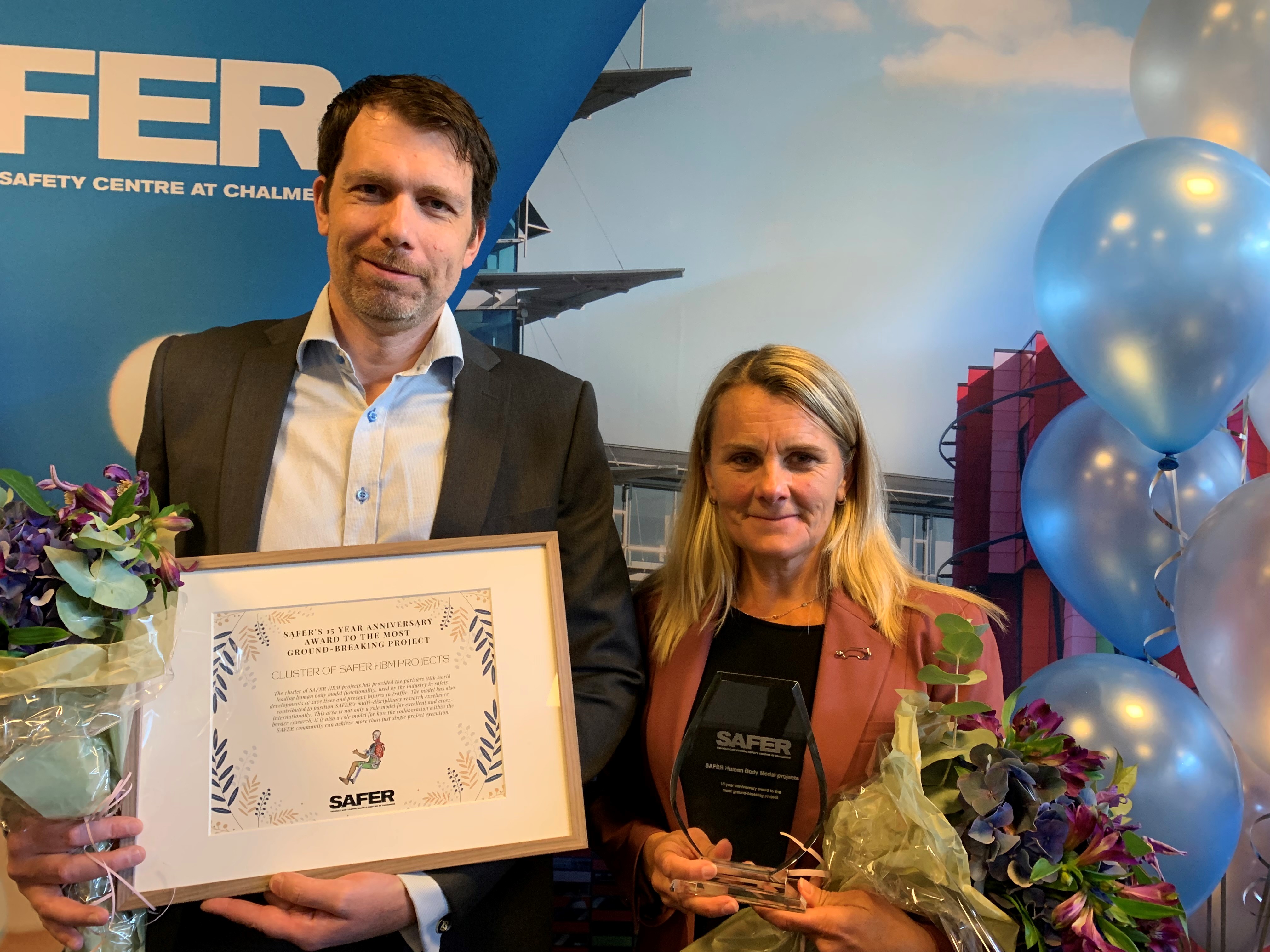SAFER’s 15 year anniversary award to the cluster of Human Body Model projects
We are very happy to announce that the cluster of SAFER’s human body model projects have been awarded the 15 year anniversary prize for the most ground-breaking project in the research- and competence centre’s history.
The award was presented during the 15 year anniversary celebrations September 29 and the jury's motivation states that:
The cluster of SAFER HBM projects has provided the partners with world leading human body model functionality, used by the industry in safety developments to save lives and prevent injures in traffic. The model has also contributed to position SAFER’s multi-disciplinary research excellence internationally. This area is not only a role model for excellent and cross-border research, it is also a role model for how the collaboration within the SAFER community can achieve more than just single project execution.
The award was presented by SAFER's director Magnus Granström:
“We congratulate everyone who has been involved in these important projects, contributing to creating SAFER’s world leading position in human body modelling as well as our entire family of human body models. Our family of human body models has contributed significantly to SAFER’s excellent research results and to our partners' product development over the years. The cluster of projects has helped to speed up the process of industrial implementation significantly, providing the SAFER partners with a state-of-the art human body model”.
World leading human body model functionality
At the early stages of SAFER, two SAFER projects were granted on the topic of Human Body Models (HBM); one focusing on injury prediction and biofidelity of the models and one exploring the possibilities of modeling muscle control, enabling the HBM to be used in evasive maneuvers potentially preceding the crash. In addition, financial support was given to Chalmers to hire a senior researcher, with the task to start building a research group within the area. Since then, numerous projects on HBM have been granted funded, mainly from FFI and Vinnova, and associated to SAFER. Continuously, SAFER partners have joined efforts in strategical discussions and shared thoughts and plans on how to proceed over time. A vision was established in early days to develop a model that was “scaleable, tuneable, with omni-directional injury prediction capabilities, and capable of high-g and low-g events”. This means a virtual human substitute that can be used for predicting injury outcome in any impact situation and direction, able to replicate a large population of people, standing as well as sitting, with humanlike kinematics in impacts as well as vehicle-manoeuvre events.
The human body models, including the knowledge obtained in the pre-competitive joint research, are used by the industry in safety developments. Fifteen years ago, this was utopia that now is reality and we are working on refinements, usability and shareability. The different projects have been designed in line with the vision and with a continuous interaction between the projects, as well as project partners, to achieve the joint model. SAFER provides a competence platform for SAFER partners as well as a natural contact point for external cooperation. The growing activity in human body modelling has already placed SAFER amongst other well-known organisations, and the interest shown by other universities proves its high academic relevance globally.
This nomination is also motivated by the area’s importance for making SAFER well known and acknowledged, as a role model for collaborative research and as a showcase on what two limited SAFER projects can result in.
Over the years, many researchers and doctoral students have contributed to the development of this important simulation tool. Lotta Jakobsson, senior technical leader at Volvo Cars and SAFER’s former research area director for Human body protection has been leading, or been part in, most of HBM projects since the early stages. She comments upon the award:
“I am very pleased and proud of this recognition! It is a result of dedicated and skilled SAFER researchers, working towards a common and clear goal”.
This award acknowledges the humble beginnings of HBM research at SAFER, the hard work of researchers involved in the cluster of HBM projects over the past 15 years and the increasing importance and relevance of these tools to the research community and industry. However, developments have not stopped now.
Jolyon Carroll, Biomechanics Specialist at Autoliv and current research area director for Human body protection confirms:
“The HBM research remains vibrant at SAFER. Projects stemming from those original seeds continue looking into injury prediction capabilities and active musculature for postural control. Furthermore, we have a live project looking to refine an HBM for use as a motorcycle rider to address injury risk for this group of road users and partners are involved in European projects making a family of scaled HBMs available openly.”
The vision has not been achieved fully yet, but we’re moving in the right direction and the usefulness and value of the HBM tools increases all the time.
This cluster of projects has been elected as the most ground-breaking projects by SAFER's partners and management team from a short list of a total of 7 nominated excellent SAFER high-profile projects; SALIENCE4CAV, Virtual, Småfolk, SAFER’s naturalistic driving databases / Euro-FOT, Cluster of HBM-projects AI Aware and Active-HBM.

